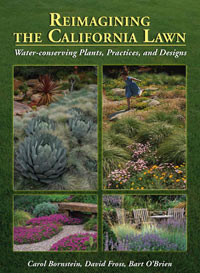Reimagining the California Lawn
New Garden Book Shows How to Reduce Water Used on Turf
The full title of this invaluable new book is Reimagining the California Lawn: Water-Conserving Plants, Practices and Designs. With this volume, the authors—Carol Bornstein, David Fross, and Bart O’Brien—have put another well-deserved notch in their pencils. Their very well-written and well-produced California Native Plants for the Garden (also published by the Santa Barbara County-based Cachuma Press) came out in 2005 to help Southern California growers choose and grow more native plants. This new offering focuses on one of the thirstiest features of most gardens—the lawn—with more ideas, not necessarily native, to reduce the wasteful use of water expended on turf.

The introduction to this useful guide, which details the fairly short history of the lawn (the first designers and advocates were from the mid 1800s) and the current costs in money, water, and environmental degradation, should convince anyone that it is high time to reimagine the lawn. Modern lawns require excessive outputs of water (estimates for the whole state are that 1.5 million acre-feet of water is applied each year—enough to supply 3 million suburban homes). They demand frequent mowing, amounting to, during only one hour of operation, the release of lawn-mower exhaust compounds that are approximately equal to a fuel-efficient car driving 350 miles. And most lawns are there just for show: Nobody spreads a picnic blanket, tosses a football, or lets baby crawl safely outdoors on them. What if that unused space could actually use very little water, look colorful without much maintenance, and maybe even attract beneficial insects or produce food for the table?
There are many ways to reimagine a lawn. This helpful resource divides the possibilities into a number of replacement options. How about a “greensward”? The authors define it as “grass, sedge, or other grass-like plants that provide a surface accessible to varying degrees of foot traffic.” They provide a comprehensive encyclopedia of these plants that can be planted to mimic that inimical urban lawn.
Next up is the concept of a meadow. The dictionary definition sounds very similar to greensward: “land that is predominantly in grass.” Botanists and other naturalists go further in admitting that meadows may contain not only grasses, but also a variety of other flowering plants, including annuals, ephemeral perennials, and bulbous plants. In terms of the urban landscape, creating a “meadow” will include a diversity of these plants along with some grassy plants. Maintenance may include a yearly mow or even a controlled burn (well, maybe only large public gardens may be able to get away with that, but that’s what nature might do).
These two options will, for at least some period of the seasons, look somewhat similar to a lawn. There are several other aesthetically pleasing options to fill that unused space. The next entries address the possibility of creating a “rock garden,” a “succulent garden” (definitely water saving), or an intriguing concept that they title “carpet and tapestry gardens,” as well as the “kitchen garden.”
The second chapter details many maintenance procedures to manage an existing lawn with less water and chemical inputs. It also gives good advice about how to remove, or at least reduce the size of, an existing lawn. The most valuable section profiles all the many plants that can be used in these strategies to reimagine any lawn. There is also an extremely valuable series of lists that sort these plant recommendations into specific categories that will help jumpstart the selection process.
Plenty of beautiful photographs, clear and concise writing, nice layout—what else could we expect?



